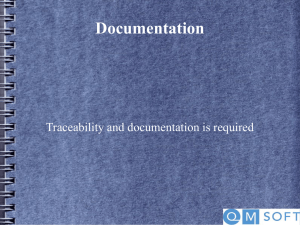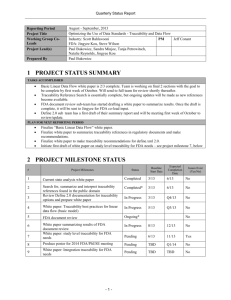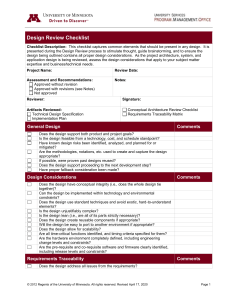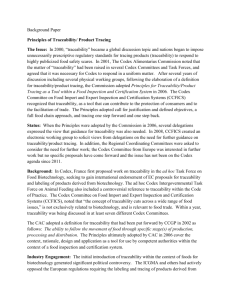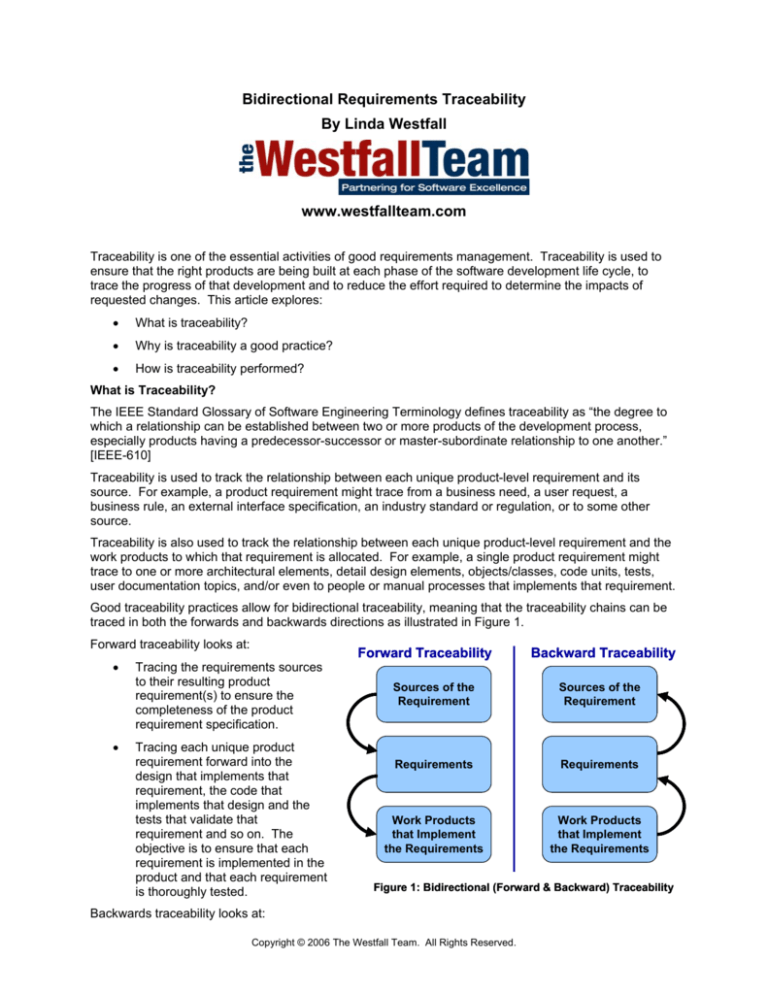
Bidirectional Requirements Traceability
By Linda Westfall
www.westfallteam.com
Traceability is one of the essential activities of good requirements management. Traceability is used to
ensure that the right products are being built at each phase of the software development life cycle, to
trace the progress of that development and to reduce the effort required to determine the impacts of
requested changes. This article explores:
•
What is traceability?
•
Why is traceability a good practice?
•
How is traceability performed?
What is Traceability?
The IEEE Standard Glossary of Software Engineering Terminology defines traceability as “the degree to
which a relationship can be established between two or more products of the development process,
especially products having a predecessor-successor or master-subordinate relationship to one another.”
[IEEE-610]
Traceability is used to track the relationship between each unique product-level requirement and its
source. For example, a product requirement might trace from a business need, a user request, a
business rule, an external interface specification, an industry standard or regulation, or to some other
source.
Traceability is also used to track the relationship between each unique product-level requirement and the
work products to which that requirement is allocated. For example, a single product requirement might
trace to one or more architectural elements, detail design elements, objects/classes, code units, tests,
user documentation topics, and/or even to people or manual processes that implements that requirement.
Good traceability practices allow for bidirectional traceability, meaning that the traceability chains can be
traced in both the forwards and backwards directions as illustrated in Figure 1.
Forward traceability looks at:
•
•
Forward Traceability
Tracing the requirements sources
to their resulting product
requirement(s) to ensure the
completeness of the product
requirement specification.
Tracing each unique product
requirement forward into the
design that implements that
requirement, the code that
implements that design and the
tests that validate that
requirement and so on. The
objective is to ensure that each
requirement is implemented in the
product and that each requirement
is thoroughly tested.
Backward Traceability
Sources of the
Requirement
Sources of the
Requirement
Requirements
Requirements
Work Products
that Implement
the Requirements
Work Products
that Implement
the Requirements
Figure 1: Bidirectional (Forward & Backward) Traceability
Backwards traceability looks at:
Copyright © 2006 The Westfall Team. All Rights Reserved.
•
Tracing each unique work product (e.g., design element, object/class, code unit, test) back to its
associated requirement. Backward traceability can verify that the requirements have been kept
current with the design, code, and tests.
•
Tracing each requirement back to its source(s).
Why is Traceability a Good Practice?
The Software Engineering Institute (SEI) Capability Maturity Model Integration® (CMMI®) states that the
purpose of the process area in “Requirements Management is to manage the requirements of the
project’s product and product components and to identify inconsistencies between those requirements
and the project’s plans and work products.” [SEI-00]. One of the specific practices under the
Requirements Management process area is to “Maintain Bidirectional Traceability of Requirements.”
[SEI-00] What is the benefit of putting in the effort to maintain bidirectional traceability?
Forward traceability ensures proper direction of the evolving product (that we are building the right
product) and indicates the completeness of the subsequent implementation. For example, if a business
rule can’t be traced forward to one or more product requirements then the product requirements
specification is incomplete and the resulting product may not meet the needs of the business. If a product
requirement cannot be traced forward to its associated architectural design elements, then the
architectural design is not complete and so on.
If, on the other hand, there are changes in the business environment (e.g., a business rule change or a
standard change), then if good forward traceability has been maintained, that change can be traced
forward to the associated requirements and all of the work products that are impacted by that change.
This greatly reduces the amount of effort required to do a thorough job of impact analysis. It also reduces
the risk that one of the effected work products is forgotten, resulting in an incomplete implementation of
the change (i.e., a defect).
Backwards traceability helps ensure that the evolving product remains on the correct track with regards to
the original and/or evolving requirements (that we are building the product right). The objective is to
ensure that we are not expanding the scope of the project by adding design elements, code, tests or
other work products that are not called out in the requirements (i.e., “gold plating”). If there is a change
needed in the implementation or if the developers come up with a creative, new technical solution, that
change or solution should be traced backwards to the requirements and the business needs to ensure
that it is within the scope of the desired product. For example, if there is a work product element that
doesn’t trace backwards to the product requirements one of two things is true. The first possibility is that
there is a missing requirement because the work product element really is needed. In this case,
traceability has helped identify the missing requirement and can also be used to evaluate the impacts of
adding that requirement to project plans and other work products (forward traceability again). The second
possibility is that there is “gold plating” going on – something has been added that should not be part of
the product. Gold plating is a high risk activity because project plans have not allocated time or resources
to the work and the existence of that part of the product may not be well communicated to other project
personnel (e.g., tester doesn’t test it, it’s not included in user documentation).
Another benefit of backward traceability comes when a defect is identified in one of the work products.
For example, if a piece of code has a defect, the traceability matrix can be used to help determine the
root cause of that defect. For example, is it just a code defect or does it trace back to a defect in the
design or requirements? If it’s a design or requirements defect, what other work products might be
impacted by the defect?
Benefits of bi-directional requirements traceability include the ability to:
•
•
Analyze the impact of a change
−
All work products affected by a changed requirement
−
All requirements affected by a change or defect in a work product
Assess current status of the requirements and the project
−
Identify missing requirements
Copyright © 2006 The Westfall Team. All Rights Reserved.
−
Identify gold plating
How is Traceability Performed?
The classic way to perform traceability is by constructing a traceability matrix. As illustrated in Table 1, a
traceability matrix summarizes in matrix form the traceability from original identified stakeholder needs to
their associated product requirements and then on to other work product elements. In order to construct
a traceability matrix, each requirement, each requirements source and each work product element must
have a unique identifier that can be used as a reference in the matrix. The requirement matrix has the
advantage of being a single repository for documenting both forwards and backwards traceability across
all of the work products.
Requirement
Source
Product
Requirements
HLD
Section #
Business
Rule #1
R00120 Credit
Card Types
4.1 Parse
Mag Strip
LLD
Section #
4.1.1 Read
Card Type
4.1.2 Verify
Card Type
Use Case #132
step 6
Code
Unit
UTS
Case #
STS
Case #
Read_Card
_Type.c
UT 4.1.032
ST 120.020
UT 4.1.033
ST 120.021
Read_Card
_Type.h
UT 4.1.038
ST 120.022
Ver_Card
_Type.c
UT 4.2.012
ST 120.035
UT 4.2.013
ST 120.036
Ver_Card
_Type.h
UT 4.2.016
ST 120.037
Ver_Card
_Types.
dat
UT 4.2.031
ST 120.037
UT 4.2.045
User
Manual
Section 12
UT 4.1.043
R00230 Read Gas
Flow
7.2.2 Gas
Flow Meter
Interface
7.2.2 Read
Gas Flow
Indicator
Read_Gas
_Flow.c
UT 7.2.043
ST 230.002
UT 7.2.044
ST 230.003
R00231 Calculate
Gas Price
7.3
Calculate
Gas price
7.3 Calculate
Gas price
Cal_Gas_
Price.c
UT 7.3.005
ST 231.001
UT 7.3.006
ST 231.002
UT 7.3.007
ST 231.003
Section 12
Section
21.1.2
Section
21.1.3
Table 1: Example of a Traceability Matrix
Modern requirements management tools include traceability mechanisms as part of their functionality.
A third mechanism for implementing traceability is trace tagging. Again, each requirement, each
requirement source and each work product element must have a unique identifier. In trace tagging
however, those identifiers are used as tags in the subsequent work products to identify backwards tracing
to the predecessor document. As illustrated in Figure 2 for example, the Software Design Specification
SRS
R00104 – The system shall cancel the transaction if at any
time prior to the actual dispensing of gasoline, the cardholder
requests cancellation.
SDS
SDS
Identifier
7.01.032
UTS
SRS
Tag
Component
Name
Component Description
Type
R00104
Cancel_
Transaction
Cancel transaction when the
customer presses cancel button
Module
Test
Case #
SDS
Identifier
23476
7.01.032
Test Case Name
Inputs
Cancel_Before_ PIN_Entry
23477
7.01.032
Cancel_After_ Invalid_PIN_Entry
8
23477
7.01.032
Cancel_After_Start_Pump_Gas
Figure 2: Example of Trace Tagging
Copyright © 2006 The Westfall Team. All Rights Reserved.
Etc
Expected
Result
Etc
(SDS) includes tags that identify the requirements implemented by each uniquely identified design
element and the Unit Test Specification (UTS) includes trace tags that trace back to the design elements
that each test case verifies. This tagging propagates through the work product set with source code units
that include trace tags back to design elements, integration test cases with tags back to architecture
elements and system test cases with trace tags back to requirements as appropriate depending on the
hierarchy of work products used on the product. Trace tags have the advantage of being part of the work
products so a separate matrix isn’t maintained. However, while backwards tracing is easy with trace tags,
forward tracing is very difficult using this mechanism.
All traceability implementation techniques require the commitment of a cross-functional team of
participants to create and maintain the linkages between the requirements, their source and their
allocation to subsequent work products. The requirements analyst must initiate requirements traceability
and document the original tracing of the product requirements to their source. As system and software
architects create the high-level design, those practitioners add their information to the traceability
documentation. Developers doing low-level design, code and unit testing add additional traceability
information for the elements they create, as do the integration, system and alpha, beta and acceptance
testers. For small projects, some of these roles may not exist or may be done by the sample practitioner,
which limits the number of different people working with the traceability information. For larger projects,
where traceability information comes from many different practitioners, it may be necessary to have
someone who coordinates, documents and ensures periodic audits of the traceability information from all
its various sources to achieve completeness and consistency.
References
IEEE-610
IEEE Standards Software Engineering, IEEE Standard Glossary of Software
Engineering Terminology, IEEE Std. 610-1990, The Institute of Electrical and
Electronics Engineers, 1999, ISBN 0-7381-1559-2.
SEI-00
CMMISM for Systems Engineering/Software Engineering, Version 1.02 (CMMISW/SW, V 1.02); CMMI Staged Representation, CMU/SEI-2000-TR-018, ESC-TR2000-018; Continuous Representation, CMU/SEI-2000-TR-019, ESC-TR-2000-019;
Product Development Team; Software Engineering Institute; November 2000.
Copyright © 2006 The Westfall Team. All Rights Reserved.



